Decorative screens for radiators: overview of different types of grilles + tips for choosing
When decorating residential premises, special attention is paid to design.Property owners strive to get away from stereotypes that have been developed over the years and use every opportunity to create an exclusive interior.
A stylish decorative screen for a heating radiator will radically transform its appearance and hide all visible imperfections.
In this material we will talk about the types of decorative grilles for batteries, and also give some tips on choosing this decorative element.
The content of the article:
Purpose of the battery screen
This versatile decorative element can be used for various purposes. The market offers consumers a variety of models of grilles made of metal, glass, wood, MDF, plastic and other materials.
The radiator grille performs the following functions:
- Protection. The design of the screen of any model makes it possible to guarantee protection of heating devices from dirt and dust.
- Decorativeness. Using this element, you can cover up old batteries that work great, but have an unattractive appearance.
- Safety. Lattices and boxes will reliably protect children from burns upon contact with coolant.
A stylish radiator grille is in demand when decorating residential and office premises. It allows you to reach a compromise between the aesthetic and practical sides of the issue of organizing heating.

Screens for batteries are a reliable design that will add some zest or help emphasize the sophistication of the created interior.
Regardless of the model you choose, you will certainly appreciate the benefits of using a radiator grille:
- It allows you to save on heating costs by ensuring uniform distribution of warm air flows throughout the living space.
- Reliably protects children and other family members from accidental contact with a hot radiator, eliminating the possibility of getting burned.
- Serves as a stylish decorative decoration for the interior, acting as an accent element or supporting the overall design concept.
- A wide range of screens for heating radiators of different sizes, shapes and designs allows you to choose the best option for any room.
- If it is necessary to update the interior, the homeowner can quickly replace the old grille with a new one.
It is worth noting that the installation of a stylish decorative screen does not at all affect the technical characteristics and properties of heating devices.
Due to the cracks that are present in most structures, the convection of hot air increases and the heat is evenly distributed over the area of the room.
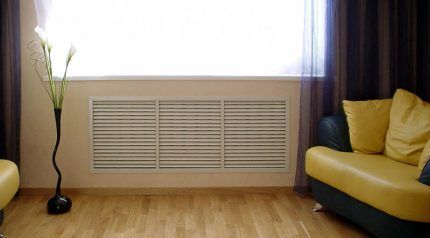
Available types of screens
Consumers are offered a wide selection of decorative grilles for batteries, which differ in size, shape, design, material of manufacture and other characteristics.
When choosing the best option, you must be guided by the task assigned to the equipment, the characteristics of the room and the personal preferences of the owner.
There are 3 main types of radiator screens:
- Hanging structures. Models of this type are used to hide old cast iron batteriesresembling an accordion. These simple decorative designs can have 1 or more sections, with or without a top cover. They are attached with hooks or placed on the fins of heating equipment.
- Flat designs. They are also called façade and are used for radiators located in niches. The products have the form of a rectangular frame, inside of which there is a sheathing. They are mounted overlapping on the wall niche so that the radiator does not protrude beyond its boundaries.
- Protective boxes. This is the best option for hiding heating devices located along the wall of the room. Screens of this type are the most difficult to manufacture and install. The protective box completely covers old radiators and looks great in any interior. The disadvantage of the product is that part of the heat remains inside it, and only 40-50% enters the room.
Radiator screens can be mobile or stationary. The installation method is selected depending on how the batteries are installed in the room. The main thing is that the structure can be easily removed.
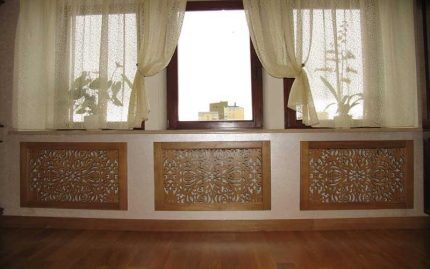
Screen manufacturing materials
Decorative protective structures for batteries are made from different materials. This affects the characteristics and price of the equipment.
The choice of the optimal model depends on the features of the interior, budget and taste of the owner of the room. The main condition is that the radiator screen must cover as much as possible the externally unattractive heating equipment and have sufficient perforation for high-quality heat transfer.

Option #1 - metal grilles
Radiator screens made of aluminum mesh or thin sheet steel are in high demand among consumers.
If the design involves the presence of large holes, then the grille perfectly transmits heat without trapping hot air flows in a closed space.
Despite the fact that the metal has high thermal conductivity, due to the reduction in surface area, a decrease in thermal power is observed.
Metal products differ in size, shape, color and pattern design. Consumers can choose openwork grilles or screens in the form of a continuous canvas. Some models are equipped with a side panel.
The service life of metal products depends on the type and quality of paint. The best option is powder enamel. It protects the metal from corrosion and remains on its surface for a long time.
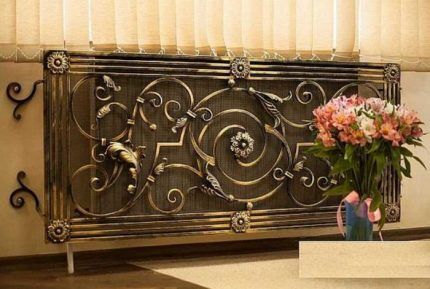
Metal radiator screens have the following features and advantages:
- Large range of models.Today you can buy products of different designs, ranging from expensive forged structures with decorative elements to standard hanging screens with perforations.
- The color of the grille must be selected to match the heating device in the apartment or the interior of the room.
- The metal has increased thermal conductivity, so it increases the area of thermal energy release by 2-3 times.
- The metal surface is easy to clean; dirt can be easily removed from it using a damp sponge.
- Metal does not have the property of deforming and changing its appearance due to changes in temperature or humidity.
- If there is perforation, the metal heats up and becomes an additional source of heat in the room.
Metal grilles are easy to install and can be easily and quickly removed for cleaning or replacement. And with proper care, this material has a long service life.
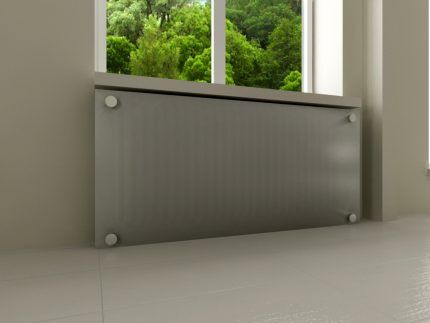
Option #2 - wooden gratings
Unique products are made from wood, suitable for rooms decorated in any style. Decorative elements made from expensive species belong to the premium class. Even inexpensive types of wood are used to create original compositions.
It is important that the radiator grille has perforations, since a product without holes will transfer some of the heat to its neighbors.
Decorative radiator screens made of oak, beech and other valuable wood are often found in classic interiors. They are usually tinted, painted and coated with high-quality enamel.
The main advantages of wooden products:
- are characterized by strength and increased wear resistance, which ensures a long period of their operation;
- visually attractive grilles made of natural wood will decorate a room for any purpose;
- natural wood is universal, it harmoniously combines with various finishing materials;
- wood is plastic in the skillful hands of a master who can create a work of art from it with unique carved fragments.
Wood is sensitive to high humidity and temperature changes. Therefore, in order to produce a high-quality product with a long service life, manufacturers must carefully select raw materials.
The material must be durable; according to the technology, it must be properly dried and treated with a protective composition.
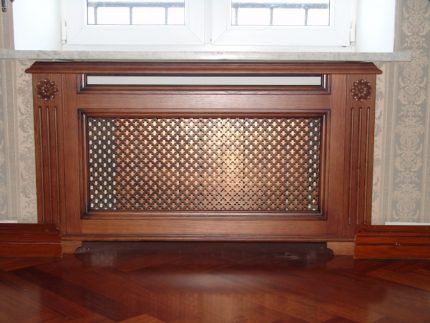
Wooden radiator grilles can be painted or not, tinted or enameled. So that they do not interfere with the normal passage of heat flows, they are often mounted not on the floor of the room, but raised above it a short distance.
To improve air circulation, holes are usually made on the top part of the box.
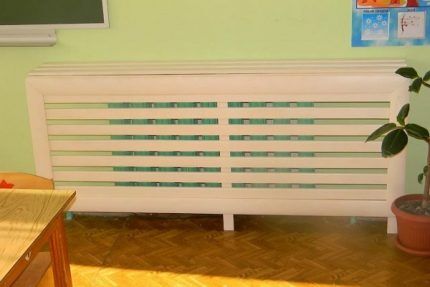
Option #3 - plastic covers for radiators
When manufacturing products, it is important to use material with a heat-resistant composition that can withstand temperatures of 70 °C. The best option is durable PVC, which when heated does not tend to deform and release harmful substances.
The pliable material allows manufacturers to produce models of original colors and shapes.
The advantages of a plastic screen are as follows:
- the product is lightweight, which makes it easy to transport;
- the material is not afraid of moisture, the grille can be used in rooms for various purposes;
- plastic is not subject to corrosion and is resistant to temperature changes;
- ease of installation and dismantling of equipment;
- easy care - the plastic surface is easy to clean without abrasive cleaners;
- Plastic screens are inexpensive.
The main disadvantage of plastic is low thermal conductivity. When significantly heated, the material begins to release harmful toxic substances, which is why plastic grilles are not used in children's institutions. Most often they are installed in office and non-residential premises.
Cheap material is characterized by low mechanical strength, so radiator screens are made of thicker plastic, which leads to significant heat loss.
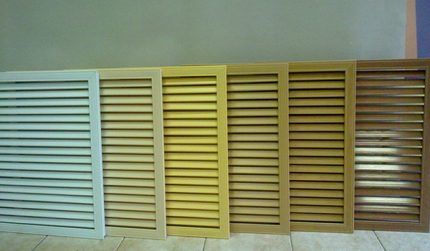
Option #4 - glass screens
When decorating modern residential premises, glass radiator screens are in particular demand. They mainly perform an aesthetic function - they have a stylish design, so they can transform and decorate any room.
Many consumers choose glass models, as they are distinguished by high technical characteristics, aesthetic appearance and environmental friendliness.
Manufacturers offer glass radiator screens of different types:
- transparent;
- matte, with aesthetic sandblasting;
- decorated with UV printed images;
- made of tempered or plain glass;
- combined with other material or completely glass.
In order to give strength to the edges of the product, manufacturers use technology bevelling and polishing. This treatment ensures safe operation and an attractive appearance of the product.
A special substance is applied to the glass, which has protective properties and allows you to clean the screen using regular detergents.

You can make an exclusive panel from an ordinary radiator. Using UV printing technology on the screen, which is a functional design element, you can apply a picture with a city panorama, flowers, animals or birds.
Options for decorating products: painting, tinting, deep etching, photo printing, satin finish.
Glass screens have many advantages:
- high heat transfer rate;
- allow you to give old-style batteries a modern look;
- a large selection of stylish decorative products;
- if necessary, you can easily dismantle it;
- Tempered glass has a thickness of 8 mm, due to this it is practically impossible to break.
Radiator screens made of acrylic glass are popular. It is up to 2.5 cm thick, but weighs much less than usual.
Thin acrylic glass comes in a variety of colors and can warp when exposed to high temperatures. The bending technology allows you to give it the required shape and create an exclusive product.

Option #5 - a box made of HDF And MDF
Decorative grilles made from HDF And MDF slabs belong to budget models. They imitate natural wood, making them inexpensive and attractive. The products are not afraid of moisture and sudden temperature changes.
Boxes from HDF And MDF They differ in shades and shapes, which allows you to choose the optimal model for any interior. Plates from MDF, HDF can serve as a basis for products made from natural wood to reduce their cost.
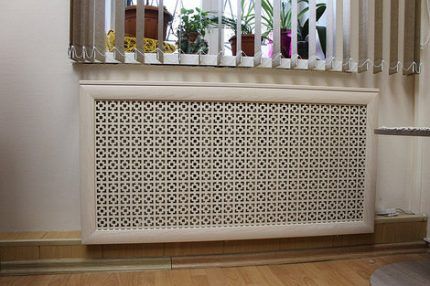
Radiator screens from MDF And HDF have advantages:
- Easy processing. The surface of decorative elements does not require additional painting.
- Good assortment. A wide variety of models in different shades and colors allows you to choose an option for any room.
- Easy care. To clean products made from this material, you can use conventional products for polished surfaces.
- Affordable price tag. Radiator screens from MDF And HDF differ in comparatively low, budget cost.
For the production of decorative screens, natural components are used, and natural lignin acts as a binder, so the products are safe for health.
HDF pressed on special equipment under high pressure, resulting in a thin material with a dense and uniform structure.
What to look for when choosing a screen?
When choosing a grille for a radiator, you must take into account that it not only covers the heating device and successfully performs a decorative function. In addition, it significantly reduces the heat transfer of the heating device installed in the room.
Depending on the properties of the model, heat transfer may decrease by 5, 10 or 50%. Therefore, when choosing a screen, it is important to take into account the heat transfer parameters. And during installation, ensure free access to the radiator valves.
This will allow you to regulate the temperature of the heating equipment at the beginning and end of the season, as well as drain water if air gets inside when starting the heating system.
The fastening of decorative grilles should provide quick, easy access to batteries and communications. Since the latter need to be regularly maintained and cleaned of dirt. Sometimes emergency situations may arise.
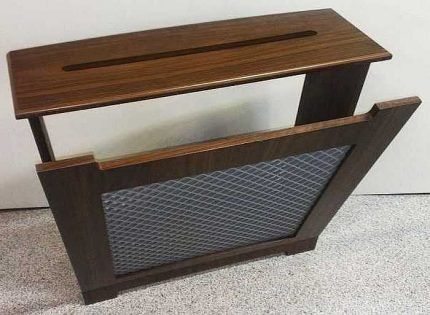
A radiator of any type emits the maximum amount of heat from the surface of the upper element.Therefore, it is recommended to choose a grille with a small top bar. This will minimize thermal energy losses.
The box cover covers the heating element on 4 sides, impeding air circulation. Therefore, products of this type are considered not the best option in terms of heat transfer quality.
When choosing a material for making gratings, you need to pay special attention to environmental friendliness and safety - after all,corative screens are exposed to constant temperature effects.
Therefore, it is better not to take suspiciously cheap and low-quality plastic - it can emit harmful fumes.
Most environmentally friendly The material is considered to be wood. You can use it to make a unique decorative radiator screen with your own hands.
We also recommend reading the article where we talked about other ways to decorate heating radiators. More details - go to link.
Conclusions and useful video on the topic
From the following video you can learn how to decorate a radiator yourself:
Protective and decorative screens are in great demand among consumers. They are used to hide an unaesthetic heating device and improve the interior.
When choosing a grille for a heating radiator, you need to take into account the indicators environmental friendliness, safety and thermal conductivity. To improve air circulation, it is recommended to leave a gap of 2-3 cm from the floor covering when installing it.
Which decorative radiator grilles did you choose? Please share your photos and tell us if you are happy with your choice? Write your comments in the block below the article.




A good and very useful thing - it looks beautiful and stylish, allows you to maintain the aesthetic appearance of the interior and at the same time does not reduce the amount of heat from the battery. We bought it from a simple plumbing store and chose metal screens. The screen, designed for four sections, completely covers the battery and fits well. They are not heavy in weight and can be easily removed to, for example, wash the batteries. Useful thing.
No one can convince me that all these design delights do not interfere with the direct function of the radiators - heating the room. It’s even strange that they advise leaving a gap from the floor. And what? Warm air rises up rather than sinking into the gap below. And if the coolant is not so hot, 50-55 degrees, for example, then because of these screens you can walk around the house in felt boots and sheepskin coats.
A normally made screen that does not interfere with the movement of warm currents does not particularly affect the heating of the room. If there is a difference, it will be a couple of degrees.
All clear.